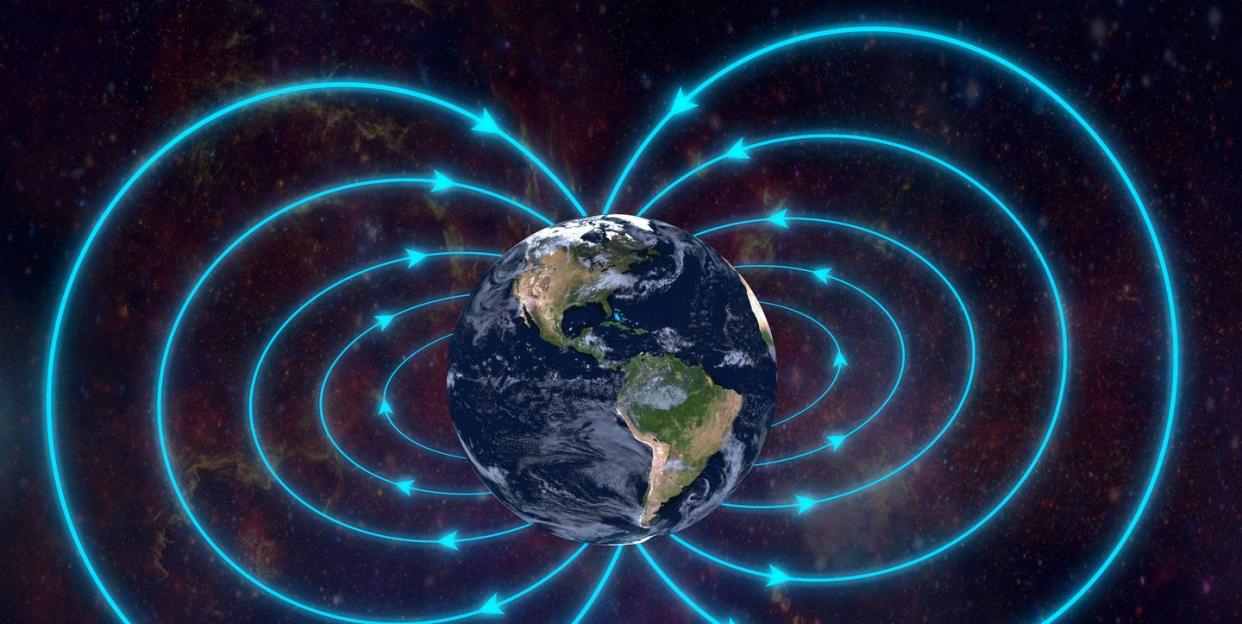Scientists Dispel Popular Theory That Earth’s Magnetic Poles Will Flip

"Hearst Magazines and Yahoo may earn commission or revenue on some items through the links below."
Earth’s history suggests our current magnetic anomaly isn’t the prelude to a pole flip.
The magnetic field guides global navigation and protects Earth from space flux.
Data on magnetic poles goes back 9,000 years, letting scientists study the poles holistically.
In new research, scientists walk back the popular idea that Earth’s magnetic poles will flip at some point soon—an event that would occur for the first time in tens of thousands of years. And while it wouldn’t be the end of the world by any means, it would complicate a lot of things for us. All of that means it’s good news that we likely won’t see a flip for at least a few hundred more years.
🤯 You love our weird world. So do we. Let’s explore it together.
In the new paper, published last week in the Proceedings of the National Academy of Sciences, researchers from Lund University in Sweden and Oregon State University identify some of Earth’s current magnetic anomalies and position them in the larger context of the last 9,000 years. Amazingly, we have pretty complete magnetic field data over that entire period. But to understand what’s going on, first we should take a crash course in Earth’s magnetic field.
Most people’s conscious experience of magnets is limited to what they see on the fridge, or maybe a beloved collection of Buckyballs (if you know, you know). Magnets are useful in other parts of your life, too, from the kitchen microwave to computers, to jewelry and bag closures. Some of these are simple mineral magnets, while others are electromagnets, where coiled wires enlivened with electricity create the magnetic energy.
Earth itself is a giant magnet. Because Earth spins and has an energized liquid metal core, it is in fact one of the largest electromagnetic dynamos we know of—essentially a power plant whose heat energy keeps us alive, while the magnetic power creates Earth’s magnetic field.
Imagine how tiny magnets repel each other at close range. Now, cast your mind out to an Earth-sized magnet that repels the charged ions that would otherwise pummel the entire planet every day. We basically live down the street from an aggressive, violent nuclear fusion super-reactor—the sun!—and this magnetic protection is so, so important.
The magnetic field is roughly donut-shaped, with poles that are similar, but not identical to, Earth’s geographic poles. The north and south magnetic poles actually drift quite a bit over time, and this is considered normal in the context of history. It affects compasses, especially for people who live in the far north. Storyteller Jeff Emtman documented his own experiences with the drifting magnetic north in rural northern Canada, for instance.

Currently, there is a “soft spot” in Earth’s magnetic field over the southern Atlantic Ocean. Like the “drifting” magnetic poles, the soft spot is messing with instruments that rely on finely-tuned magnets. As scientists scrutinize this anomaly over time, it has led some to believe we’re on our way to a magnetic pole flip. That’s just what it sounds like: compass north becoming compass south over a very short period of time. That would cause chaos with Earth’s systems, especially in navigation and the gigantic industry of overseas shipping.
So you can see why it was a big deal when researchers started to believe a magnetic-pole flip was coming. But now, evidence may suggest we have much more time. “Using archeological and geological records, we have reconstructed the variations of Earth’s magnetic field over the past 9,000 [years],” the researchers write in their new paper. “We propose that the period around 600 BCE, characterized by a strongly asymmetric field, could provide an analog to the present-day field.”
🌍 Earth Is Pretty Damn Weird
Earth Will Become One Big Supercontinent Again, And It Will Probably Kill Us, Scientists Say
Scientists Spot Trippy Waves Rippling Across Earth’s Outer Core
The Magnetic North Pole Is Rapidly Moving Because of Some Blobs
The researchers have taken 9,000 years of data and basically processed it from the very beginning, correcting flaws they say were present in previous approaches to the huge data set. By using probability, these scientists can better contextualize some issues like the exact age of certain events. And this approach allows them to see patterns as far back as previous times of large magnetic-field asymmetry.
In the billion-year timeframe of Earth’s life, the last magnetic pole reversal 42,000 years ago is honestly not that far back. But it’s far, far longer ago than the anomaly scientists identified just 2,600 years ago, where the big magnetic field soft spot lasted several hundred years and then disappeared. This, the scientists conclude, is the most likely outcome for our southern Atlantic anomaly.
Yes, it will likely last a few hundred more years and continue to complicate certain instruments and navigation, but it is not precipitous of a magnetic-pole flip. And in 2022, won’t we take any small sigh of relief we can get?
You Might Also Like

